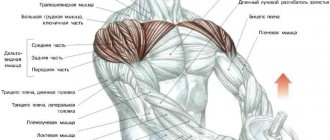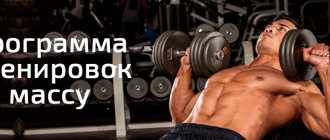What is strength training for?
Strength training (anaerobic training) is a set of exercises aimed at developing and strengthening muscle mass, changing body shape and correcting figure flaws. Strength exercises allow you to build muscles, work out their silhouette, improving the appearance of your body.
Anaerobic exercises are performed with weights. Exercise equipment and free weights are used as weights - dumbbells, barbells, kettlebells, weights, elastic bands. The working weight is selected individually depending on the training plan and physical fitness of the athlete.
Strength training in combination with aerobic exercise allows you to change metabolic processes, helping to fight the “plateau” in weight loss and achieve effective weight loss with long-term results.
Strength training in a group
This type of strength training is suitable for those who want to effectively work out all major or individual muscle groups in a short time. The duration of the classes does not exceed 40-50 minutes, the pace of the exercises is set by the instructor. The benefits of strength training in a group include team spirit and a competitive element as additional motivation for lazy athletes.
Most popular destinations:
- Body Pump, Shock, Sculpt – a strength exercise to work the muscles of the whole body. Performed with various free weights under the guidance of an instructor and accompanied by music.
- ABS, ABL, Lower and Upper Body – strength training for working individual muscle groups (abdomen, arms, legs, buttocks, etc.)
- Interval Training is a workout that alternates cycles of aerobic and anaerobic exercise. The duration of the cycle is set by the instructor. Interval training allows you to speed up the fat burning process and tighten your body muscles.
Individual strength training
Athletes who, for one reason or another, do not want to train in a group can choose individual training. Exercises are performed in the gym or at home using machines or free weights. The athlete chooses the sequence of exercises, pace and weight independently.
The effectiveness of strength training largely depends on the technique of performing the exercises. Incorrect positioning of the body, jerking, and incorrect amplitude can reduce performance to a minimum, and in some cases lead to serious injuries. Individual lessons with an experienced instructor have obvious benefits for beginners and athletes who are unsure of their technique.
There are various methods of individual strength training:
- Full Body – all major muscle groups are worked out in one workout;
- Split – strength loads are given to separate muscle groups on different days;
- Interval Training – alternating aerobic and anaerobic exercise during one workout.
(3) The workout should not be too long - about 1 hour.
That's right, metalbrazer. As stated, muscle growth and strength come from INTENSE training. And in any textbook for physical education colleges (believe it or not?) it is written in black and white: “the intensity of training and its duration are mutually exclusive concepts.” And again, what the hell do you do in the gym for more than an hour? Five, well, six approaches per muscle group, a couple of exercises... What else is there to wipe off? No, brothers, if two hours of training gives more results to someone than one hour, then, as they say, the flag is in your hands and the car is fucked. But I have NOT met such people.
Duration and frequency of strength training
During strength training, micro-traumas to the muscles occur, and the body needs time to recover. Experts recommend that beginners avoid overly intense exercise and include strength training every other day, alternating it with rest days or cardio training. The same option is suitable for Full Body training. In Split programs, the muscle groups being worked alternate with each other on different days.
A workout is considered effective if its duration does not exceed 1 hour. Experts believe that this time is enough to work out the necessary muscles and start the fat burning process.
Features of women's training
Strength training for women has some features due to metabolism, the distribution of fat and muscle mass, the hormonal system, and the presence of the menstrual cycle.
The opinion that by training with heavy weights you can get a masculine figure is wrong. The female body produces tens of times less of the hormone testosterone, which is responsible for muscle growth, so women should not be afraid of strength training.
The most effective workout for losing weight is long-term aerobic exercise while keeping your heart rate (heart rate) level at the lower limit. Women are advised to avoid interval training.
The menstrual cycle also dictates its own rules. If your health allows, then training at the beginning of the cycle will be most effective. After the ovulation period, the female body begins to accumulate energy to bear offspring, and intensive training does not make sense.
Women are recommended to work on the upper muscles (back, biceps, triceps), high-repetition training of the legs and buttocks, a balanced diet with calorie counting and regular aerobic exercise.
(5) Rest and proper nutrition.
Well, I hope everything is clear here. Muscles grow during rest, NOT during training. And it is clear that muscles will NOT be able to grow if they have NOTHING to grow from. 2.0 g of protein per kilogram of body weight is the minimum. Moreover, this protein must be complete, i.e. obtained from animal products. Carbohydrates – 3-4 grams per kilogram of body weight. Well, the fats will “come” themselves. Food should be of high quality, natural, and NOT consist of “empty calories.” Empty calories are foods that contain only energy, but are poor in nutrients and fiber. Empty calories (all kinds of chips, sugar, candy, processed foods and other crap) are practically NOT able to promote muscle growth and do NOT bring health benefits, and often even harm. There are some idiots who claim that muscles will grow even with a fairly meager diet. They will, they will, of course, they will, only then there is no need to whine on all sorts of forums about how you were injured. And the trick is that during training NOT only muscles are loaded, but also ligaments and tendons, and nutrients are also needed for their restoration. But protein is NOT only necessary for muscle growth. Peptide compounds and individual amino acids perform a huge number of functions in the body, which, of course, you don’t give a damn about, as long as your biceps bulge.
Weight loss workouts
Weight loss occurs when more calories are consumed than consumed, so the main percentage of success depends on properly organized nutrition. Strength training, unlike cardio, allows you not only to burn calories, but also to maintain muscle mass. The principles behind strength training for fat loss are:
- Increasing the number of repetitions and reducing working weight.
- Reduce rest between sets.
- Including sets and supersets in your training, when several exercises are performed one after another without rest between approaches.
- Increasing the number of workouts during the week.
- Adding 20-30 minutes of aerobic exercise after performing strength exercises.
Theory? Practice! Methodological foundations of strength training (D. Kasatov, A. Grachev)
Rate this post
To successfully plan training, you need a clear understanding of the processes caused in muscles by physical activity of various types.
First of all, let's focus on the composition of the muscles. Muscle fibers are divided into two, fundamentally different in the way they obtain energy for work, type. These are slow-twitch muscle fibers, or MMV for short, and fast-twitch muscle fibers, or FMV. The difference in the rate of contraction of these muscle fibers is not significant. 110 milliseconds and 50 milliseconds, respectively. A more important difference between these types of muscle fibers is the way they are supplied with energy. Table 1 shows the differences between different types of muscle fibers.
Without going into details of biochemistry, I will only say that the function of the IMF is long-term low-power work, for example, long- and medium-distance running. And the function of a BMW is short-term work, but it requires a lot of power. At the same time, do not forget that MMVs work all the time: both at low power and at maximum, when BMWs are connected to help them.
What happens in powerlifting when muscles engage in short-term (2-10 seconds) maximum tension? Without any doubt, both MMV and BMW fibers work here. Moreover, both types are in maximum power mode, so a powerlifter needs to train both MMV and BMW fibers. However, both types of fibers need to be trained by a bodybuilder. After all, by neglecting the hypertrophy that is predominant in the human body, the bodybuilder obviously loses to those who either train the MMV, or to those who naturally have a ratio of MMV to BMW in favor of the latter.
The conclusion that all powerlifters and bodybuilders need to work on both BM hypertrophy and MM hypertrophy is quite obvious, but I have never met anyone in the gym training MM. Unfortunately, in the world of strength sports, an approach that has been hammered into people for decades, based on extensive practice, is very common: 3-6 repetitions in an exercise increase strength to a greater extent, and 8-12 - volume. Is it true? Of course this is true. If this were not true, then these recommendations would not be followed by thousands of amateur lifters. But this “truth” compares only two limited approaches. Training in which the weight of the barbell is fixed and the range of motion is full. A person who follows this approach limits himself in muscle development. Jocks lift the barbell 8-12 times, and lifters 3-6. The jocks are somewhat more massive, and the lifters are somewhat stronger. The thing is that with this approach, jocks and lifters develop slightly different types of muscle fibers. Neither one nor the other trains MMF at all, because they don’t know how, and most often they don’t even know about the existence of different types of muscle fibers. But first things first. So, what conditions are necessary for hypertrophy, and therefore for increasing muscle strength?
The main condition is the presence of impulse activity of the motor neuron as a factor of neurotrophic control. Simply put, muscles must contract. That is, training is necessary.
At the stage of RNA synthesis:
The presence of free creatine, adenosine monophosphoric and inosinic acids in the muscle, which is also created as a result of weight training.
The presence of hydrogen ions in the muscle cell. They are a consequence of heavy load on the muscles.
At the stage of protein synthesis:
Presence of necessary steroid hormones;
The presence of free amino acids (as components of contractile proteins - building material) and peptides, that is, there must be a complete supply of the athlete’s body with protein food.
What does all this mean to us in simple language? First of all, you need to remember that MMV and BMW training are different.
Training aimed at hypertrophy (increase) of MMV fibers:
1. The load on the bar is 30-50% of the maximum.
2. The amplitude of movement is partial, the speed of movement is low.
Explanation: Partial range of motion is necessary so that the blood vessels supplying blood to the working muscle are compressed by that same muscle. The muscle is tense all the time and the vessels are clamped. (There is a concept of a vessel - a collateral, which, with severe hypertrophy, bypasses the muscle) Oxygen does not enter the IMV muscle fibers, and resynthesis of creatine phosphate does not occur. Accordingly, free creatine accumulates in the muscle. It is one of the most important factors in the growth of muscle fiber. That is, the goal of training is to create a high concentration of free creatine in the muscle. And this is precisely the difference between training MMV and BMW. In MMV, in order to create high concentrations of free creatine, it is necessary to eliminate the access of oxygen to muscle cells. What is achieved, for example, by partial amplitude. For BMW, it is enough to simply perform the exercise with a sufficiently high intensity until the muscle fails.
3. The exercise time is 30 seconds. Then 30 seconds of rest and the approach is repeated.
4. After performing 3 approaches with a rest of 30 seconds between them, a pause of 5-10 minutes is made and a series of three approaches is repeated. Thus, three series of three approaches are performed per workout. Rest between series 5-10 minutes, between sets 30 seconds.
5. The task is to select the load so that in the final approach in the series it is very difficult to perform the exercise in the last 10-15 seconds. There should be a burning sensation in the muscles.
Workouts aimed at growing BMW fibers:
1. The load on the bar is 70-85% of the maximum.
2. The amplitude of movement is full, the speed of movement is the maximum possible with a given load.
3. The time the muscles are under load is 10-15 seconds.
4. Rest time between approaches is 5-10 minutes.
5. The task is to select a load so that in 10-15 seconds of work it causes muscle failure
With the help of the training described above, we stimulate the growth of most muscle fibers, but this work is not enough to realize maximum strength. There are also BMWs that turn on only when the load is maximum or near maximum. The training described above does not involve these muscle fibers, and, accordingly, does not cause their hypertrophy and an increase in their strength. Let's call them high-threshold BMW fibers. These are glycolytic BMWs innervated by high-threshold motor neurons. The axons of these motor neurons do not transmit the signal to the muscle fibers if the load on the muscle is not too significant. To work on high-threshold BMWs, there is a third type of training. These are traditional approaches with 5-10 minutes of rest between them. Number of repetitions from one to four, until failure. Optimally, two to three repetitions. The number of approaches is 4-7. And most importantly, the load value is 90-100%. Additionally, an excellent method for stimulating the growth of high-threshold BMWs is the negative repetition method. With this method, the athlete works in the lowering phase of the barbell. It resists lowering the weight, usually five to ten percent above the maximum. The bar should move as slowly as possible. An assistant helps the athlete lift the barbell to the starting position.
In the methods described above, we achieve high concentrations of free creatine and hydrogen ions in each specific type of muscle fiber, forcing the exact type that we planned to train to failure. This is what stimulates the growth of muscle fibers. Now it becomes clear to us why the traditional approach that a small number of repetitions increases strength, and a large number (8-12) increases volume, works. But, as we have seen, this approach is far from ideal, just as the products of the Volzhsky Automobile Plant are far from Formula 1 racing cars.
An important element in achieving maximum strength is working on the nervous system and coordination. All human movements occur under the influence of nerve signals. The human brain does not include 100% of its muscle fibers under any circumstances. However, it is quite possible to increase the number of muscle fibers activated during maximum loads. First of all, the high-threshold BMW training described above is an excellent method for achieving this. Negative repetitions are especially effective here. But these methods have a serious drawback - they cannot be used often. So the break between training with negative repetitions should be at least ten days. Usually this is two weeks. But the development of coordination of movements and neuromuscular signals should take place more often. To do this, training is done for one or two repetitions with a load of 90-100%. Rest between sets for 5 minutes. An important difference between such training for coordination of movements and training for high-threshold BMWs is that here we in no case reach failure. The emphasis of these workouts should be on perfect technique for performing the movement, not on the weight on the bar.
In order to maintain high levels of creatine phosphate and enzymes in muscle cells, between heavy workouts we give light. Light training is not aimed at muscle hypertrophy and is performed with 50% weight for 10-12 repetitions in three to five sets with a rest of 3-5 minutes between sets. As a rule, it is done a day or two before a heavy workout on BS fiber.
Another method of working on engaging the maximum number of motor units is “fast” presses, plyometric push-ups and jumping jacks.
These three methods differ in that the load in them is not significant. And they can be used to combine light training and training to activate the maximum number of motor units in the brain - muscle fibers.
To increase muscle mass, you should not neglect the increase in muscle capillarization and glycogen reserves in the muscle. However, muscle mass at any cost is needed only by bodybuilders, and I will not describe methods to achieve this within the framework of this article.
The workouts that I described above are the building blocks needed to build an individual training program for a successful athlete. How can these bricks be stacked so that the result is not a Leaning Tower of Pisa, but a slender skyscraper? I have described methods for loading muscle fibers and training their working qualities. But the load is only a stimulus for growth. The growth of muscle fibers, and, accordingly, their strength, occurs under the influence of factors such as nutrition, sleep, rest, hormonal levels, and psychological comfort.
Very often you can hear a person say that “I am not genetically gifted, and therefore I cannot progress like the champions.” But what's stopping you? Let's figure it out. What do human genes determine? First of all, muscle composition. That is, we all have different levels of different types of fibers in our muscles. But we have already learned how to train muscle fibers of all types. This means that a person whose MS fibers predominate over BS fibers can no longer argue for his lag. It is enough for him to focus training on MS fibers. This means that the composition of muscle fibers, as a factor of genetic discrimination, disappears. Here, taking into account the knowledge gained, we are all equal. Sleep, nutrition, rest, psychological comfort. These recovery factors are completely independent of a person's genetics. Exclusively from a person’s discipline and external factors. What remains? What remains is the hormonal background. It is he who puts athletes in unequal conditions. One produces more testosterone. Another insulin. The third has a high production of tyrosine. Many athletes solve this problem of genetic inequality by taking synthetic hormones. In response to this, a large number of sports organizations introduced the concept of doping. Thus, for them, an athlete, deprived by nature at the genetic level, obviously loses to an athlete gifted with a high production of anabolic hormones, even if the former turns out to be more hardworking and has greater knowledge. The topic of doping in sports is a slippery topic and has a bad smell. I propose to leave it and move on to discussing the problems of restoration.
It turns out that the speed of recovery after training is limited by external, and not internal, factors for the body. And each person has their own ability to deal with these factors. Some people can provide themselves with exceptional nutrition, some people get long sleep, some people do not experience stress, and so on. In fact, speaking, it will not be possible to become a successful athlete with at least one “lame” component of recovery. However, life dictates its own conditions to people, and not everyone is able to organize restoration processes at the proper level. For such people, I can only recommend increasing the number of rest days between workouts. As for disciplined and selfless fighters against gravity, my recommendations for them are as follows:
1. The training program is built on the basis of the tasks that you set for yourself.
If your goal is muscle mass, then neuromuscular coordination training should be completely excluded from your program. In addition, in your case you need to take care of training more muscle groups than in the case of powerlifting. Another difference in the basic training of a powerlifter and a bodybuilder is that the latter includes methods for the development of capillaries and glycogen reserves in muscle fibers in their training program at the stage of pre-competition preparation.
2. It must be remembered that for athletes who do not use synthetic hormones, the hard part of one workout should not be more than 40 minutes. It is better to train shorter in time, but as often as possible.
3. The growth time of muscle fibers is 10-14 days.
4. Workouts that do not cause destruction of muscle fibers can be repeated more often than once every 10-14 days. These are training for MMV fibers, training for neuromuscular coordination and “light” training to increase the level of creatine phosphate and enzymes in muscle cells. The muscle group loaded with these methods recovers sufficiently in 2-7 days.
5. Cycle loads in your program. For example, load muscle fibers of all types for two weeks without waiting for their complete recovery. And for the next two weeks, reduce the load and limit yourself to training that does not cause hypertrophy of muscle fibers. That is, the training from point 4.
6. It makes sense to spend periods of training only on MMF and only on MMV fibers, and based on the progress in each case, draw a conclusion about which types of muscle fibers to focus on in your training. The analysis should be done for each muscle group separately according to its strength indicators.
7. When creating your program, do not forget that the same muscle group can be used in different exercises. In such cases, space out your workouts in exercises that target the same muscle group. For example, deadlifts and squats with a barbell. For bodybuilders, it makes sense to exclude deadlifts from the program completely. The emphasis is on the legs in squats and on the back in various pulls of blocks and barbells to the chest and abdomen. For powerlifters, I recommend doing deadlifts every 10-14 days.
At the end of the article, I give an example of a training program aimed at increasing muscle mass and strength of muscle groups working during the bench press - table No. 2, an approximate training plan for a powerlifter in the bench press.
The cycle is 18 days. (For those who recover well).
1. Bench press in a shirt 4-5 sets of 2-3 reps, the third and fourth sets to failure. After this, negative for 1 time, two approaches
2.
3. MMV training (push-ups)
4.
5. Bench press without a shirt 10-12 times to failure 4 sets, rest between sets 7-10 minutes
6.
7. Rapid bench press, six sets of three to four reps in a soft vest with 60% weight, lower at normal speed, shoot up at maximum
8.
9. Bench press in a shirt 4 sets of 3-4 reps, all sets not to failure (there is strength left for one more repetition), rest 5-7 minutes. After this, three approaches to singles with a non-maximum weight and ideal technique, resting for 5 minutes between sets
10.
11.
12. MMV training (triceps on the block)
13.
14. Triceps on the block 10-12 times to failure 4 sets, rest between sets 7-10 minutes
15.
16. Fast bench press. thorough warm-up and six sets of three to four reps in a soft shirt with 60% weight, lower at normal speed, shoot up at maximum, rest between sets for a minute
17.
18. Let's move on to day one
Cycle 21 days. (For those with poor recovery).
1. Bench press in a shirt 3-4 sets of 2-3 reps, the third and fourth sets to failure. After this, negative for 1 time, one approach
2.
3.
4. MMV training (push-ups)
5.
6. Bench press without a shirt 10-12 times until failure, 4 sets. rest between sets 7-10 minutes
7.
8.
9. Fast bench press, thorough warm-up and three sets of three to four reps in a soft shirt with 60% weight, lower at normal speed, shoot up at maximum, rest for a minute between sets
10.
11. Bench press in a shirt 3 sets of 3-4 reps, all sets not to failure (there is strength left for one more repetition), rest 7-10 minutes. After this, three approaches to singles with a non-maximum weight and ideal technique, resting for 7 minutes between sets
12.
13.
14. MMV training (triceps on the block)
15.
16. Triceps on the block 10-12 times until failure, 4 sets. rest between sets 7-10 minutes
17.
18.
19. Rapid bench press, six sets of three to four reps in a soft vest with 60% weight, lower at normal speed, shoot up at maximum
20.
21. Let's move on to day one











